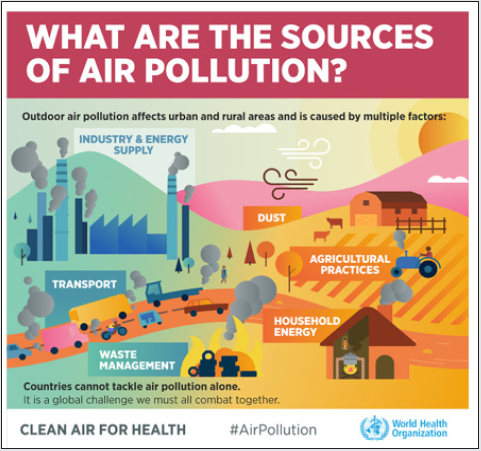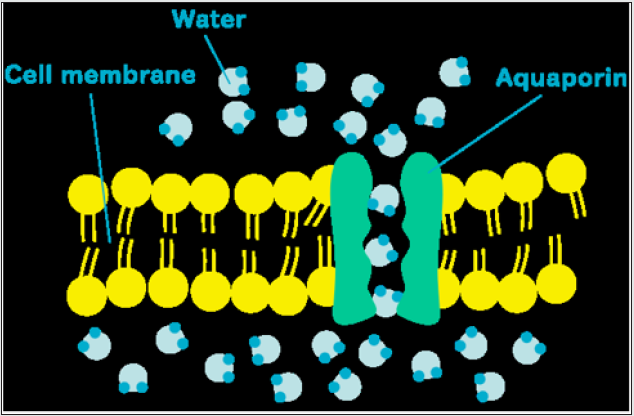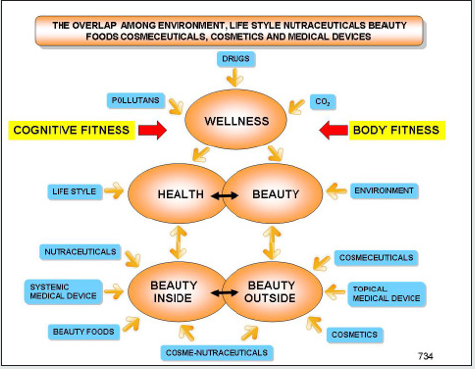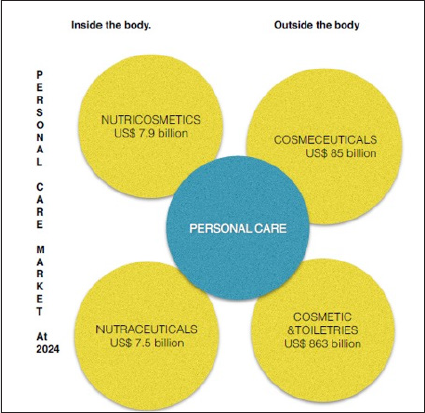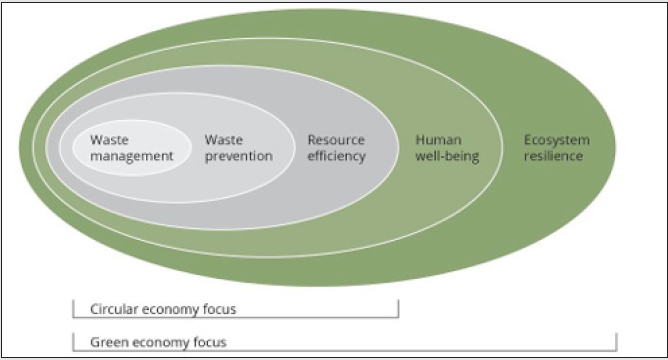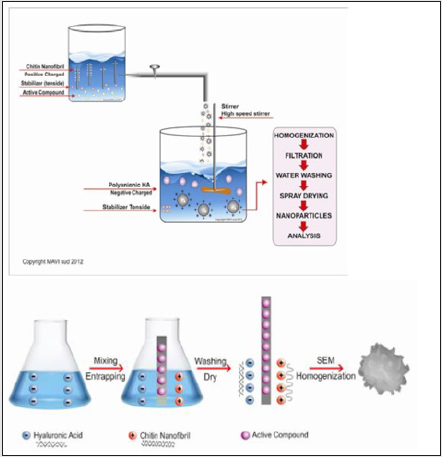
Lupine Publishers Group
Lupine Publishers
Menu
ISSN: 2637-4595
Review Article(ISSN: 2637-4595) 
The New Renaissance of Beauty and Wellness Through the Green Economy Volume 4 - Issue 2
Pierfrancesco Morganti1*, Gianluca Morganti2, Adnan Memic3, Maria Beatrice Coltelli4 and Hong- Duo Chen5
- 1History of Health Care Art, Rome, Italy; China Medical University, Shenyang, China
- 2ISCD Nanoscience Center, Rome, Italy
- 3Center of Nanotechnology King Abdul Aziz, University of Jeddah, Saudi Arabia
- 4Department of Civil and Industrial Engineering, University of Pisa, Italy
- 5Department of Dermatology, the First Hospital of China Medical University, Key lab of Immunodermatology, National Health Commission, Ministry of Education, Shenyang, China
Received:July 27, 2021 Published: August 11, 2021
*Corresponding author: Pierfrancesco Morganti, History of Health Care Art, Rome, Italy; China Medical University, Shenyang, China
DOI: 10.32474/LTTFD.2021.04.000185
Abstract
Beauty and wellness remain for both women and men an important target also because the global attractiveness is considered
a cue indicating the ability to maintain beauty and wellness. Consequently, neuromarketing has born, as an innovative mean to
interact with consumer’s trend, actually looking for high-quality and natural cosmetics and food. By the biometric studies, in fact,
it seems possible to verify the consumers’ willingness to buy the right products they are looking for. On the other hand, customers
are requesting cosmeceuticals and nutraceuticals which, acting positively on the superficial appearance of face and body, seem to
be able to boost the immune system also, limiting the stress conditions. This general disease is induced by the actual way of living
in a planet invaded by a great quantity of waste released from the human’s activities. The consequent pollution alters the ecological
balance of the body, influencing negatively the life of animals and plants also. Thus, the induced stress, further increased by the
COVID-19 spread, could change the neural conditions of human brain. Consequently, in humans could decrease production of stem
cells and cortisol from the neurons, while in plants the pat-terns of growth could affect both cuticle and stomatal conductance of the
leaves. Thus, the brain, under condition of psychosocial stress, actively demands energy from the body eliciting a marked increase in
eating by a major intake of carbohydrates, removed from the requirements of other organs. In any way, pollution provokes a widerange
of adverse health and social effects, further worsen by an increased worldwide aged population who, requiring more food and
goods increases the waste production.
What the proposed solution?
To change the actual way of consumption and production, it is necessary to optimize the re-sources of raw materials, minimizing
waste that should be recycled and reused by a green economic approach. Therefore, the need to realize a new industrial Renaissance
reducing the use of natural material by the utilization of waste by-products and sustainable technologies at low consume of energy
and water. So doing, it will be possible to maintain the human wellbeing in an environment in which the species’ biodiversity could
be assured. At this purpose, chitin nanofibrils(CN), nano-lignin (LG) and their derived compounds have been proposed to make
nanoparticles (NPs) by the use of water as solvent. These NPs, loaded by different active ingredients and bound on the surface of
natural bio-fibers may be used to make biodegradable carriers structured as innovative non-woven tissues and films. Depending on
the polymers selected to make the micro-nanocomposites and the actives loaded into the fibers, these new vehicles may be used
to produce smart cosmeceuticals, nutraceuticals or advanced medications. It is interesting to underline that all these innovative
NPs and tissue/films can be produced by natural polymers and ingredients, obtained from waste materials, and produced by
sustainable technologies at low consume of water and energy, according to the new green economy.
Keywords: Anxiety; stress; wellness; health; COVID-19; beauty; cosmeceuticals; nutraceuticals; chitin nanofibrils; nanolignin; nanoparticles; non-woven tissues; films; environment; green economy; pollution
Introduction
Ten years ago, during the 7th Congress of the International
Society of Cosmetic Dermatology [1], many scientists coming from
East and West Countries discussed on the strict relation existing
between human wellbeing and health. In that occasion the freethinking
of the Chinese doctor Sun Simiao in IV century BC was
remembered : “a good doctor first finds the cause of the illness, and after finding it, he tries first to cure it with food, if the food
doesn’t give results then he prescribes medicine, because whatever
helps the body can be considered medicine and at the same time
nourishment”. However, for Ancient Chinese, but for Romans also,
food, exercises and the way of living, have to be regulated without
anxiety by the continuous self-examination of the body, as practice
of wellbeing. Thus, according to the concept of Wu-Wei as part
of ancient Taoist tradition, humans are in state of harmony only
when they move and operate in a dynamic, spontaneous way.
Consequently, it is possible to control lost of stress over condition by
meditation, breathing and exercises, as reported from Traditional
Chinese Medicine (TCM) as well as from ancient Romans ,thinking
and living by the principle: Mens sana in corpore sano (a healthy
mind in a healthy body).
Ancient peoples, therefore, understood and considered
important to limit anxiety and stress for maintaining wellbeing,
without knowing the physiological body-immune system
connections. Thus, during the last ten years many scientists have
tried to better understand the inter-connections connecting the
level of behavior to the level of neural activities and structures of
the brain. The stress conditions, in fact, involve all the principles of
learning and memory, including the decision-making mechanisms
[2]. Coming back to the papers presented 10 years ago it seems
necessary to put some questions. Have we sufficient knowledge on
stress and the brain neural circuits? Can innovative neurocosmetics
modify the stress condition acting on the Nervous, Immune, Cutaneous,
Endocrine (NICE) systems, as reported from some scientists
10 years ago? [1] Does consumers reduce stress, ameliorating their
appearance by the use of smart natural- oriented cosmetic and diet
supplements? Have been developed new scientific knowledge on
stress and aging to ameliorate beauty and wellness by innovative
products?
Environment and stress
During the last ten years it has been shown how the brain’ organization and its neural circuits are changing, forced by the high increase of the many environmental and social stresses, caused by our modern industrialized society [3]. Thus, while the relative neuroendocrine responses are critical for the individual’ survival, the repeated exposure to stress results deleterious for health and wellbeing also. These the reasons of the extreme increased rate of diabetes, heart disease, cancer, Alzheimer and autism and other diseases, registered as probably consequent to the control lost(stress) over the protective mechanisms of human body. Therefore, the capacity to survive for the entire species has been drastically reduced, continuing its rate year by year. But which the causes of stress and the consequences on our body? There is a growing evidence that pollution, doubled for every five years’ time interval from 1950 up today, is no more a merely annoyance but a real plague of the modern society. The actual waste, in fact, causes numerous and increasing adverse health, social and economic effects on humans, animals and plants, disturbing their normal way of living. As a consequence, contaminants of the environment have a negative impact on health, leading to stress and skin aging [4]. Thus, according to the World Health Organization’(WHO ) report, indoor and outdoor air pollution kills worldwide and every year an estimated 7 million people (Figure 1) while 9 out of 10 people breathe air containing high level of many pollutants that exceeded the established healthy limits (Figure 2) [5]. Therefore, the consequent diseases may be considered as the result of maladaptation to a completely new environment of the last 2-3 generations, to which the population of the industrially developed countries was not genetically adapted [6,7]. Consequently, many illness-es, called civilization diseases, are the direct result of a continuous stress of the health of population, living in industrialized countries where the ecological balance seems irretrievably endangered.
Figure 1: Indoor and outdoor air pollution as environmental risks for health (by courtesy of WHO [5]).
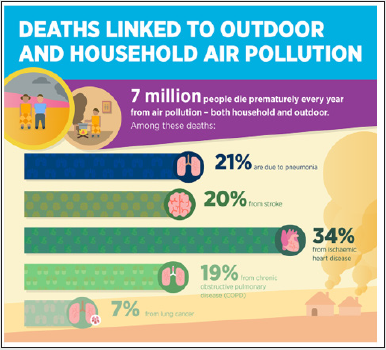
Under the conditions of psychosocial and environmental stress, the brain demands more energy, in order to cover its increased energy needs for the body. It elicits, therefore a market increase in eating behavior during the post stress phase, so that cerebral glucose supply is enhanced, while its content into peripheral tissues is reduced [8]. Brain, in fact, occupies a special hierarchical position in human energy metabolism, characterized by a high energy consumption and a low energy capacity. Thus, under condition of stress or nutrient deficiency this fundamental organ safeguards its own energy supply. Activating, therefore, its regulation system by the aquaporins (AQPs) structure, the brain sacrifices the energy required from other organs [9]. Just to remember, AQPs are water channels of hydrophobic proteins, which, forming pores in the membrane’ biological cells, facilitate the intercellular transport of water, small solutes and gas emissions, indispensable for all the biological reactions (Figure 3)[10,11]. By the same way AQP3, which decreases with aging, seems to be involved in skin hydration, skin elasticity and wound healing,as well as in cell migration of keratinocytes, underlining the importance of water for the entire body [12-14]. Thus, an ameliorated skin hydration, stimulated by the use of the right cosmetic products, increases the consumers’ perception of attractiveness compared to no cosmetics, reducing probably anxiety and stress, often connected with a facial appearance considered not enough nice [15]. People, in fact, “feel better about themselves when they think they are attractive to others” [15].
In conclusion, the actual way of living and the high pollutionlevel, have an important negative impact on beauty and wellness caused by the anxiety further increased from COVID-19 pandemic. This unknown virus pandemic , in fact, has shown to be very dangerous, not only because unusual and very contagious, but also for the waste pollution and waste created by the great quantity of non- biodegradable materials used to make surgical face masks and other protective equipments, necessary for the hospital ‘personnel and normal consumers [16]. Unfortunately, COVID-19 until now has infected 107,588,515 people causing 2,356,198 death (Worldometer,10 February 2021) with an estimated nonbiodegradable plastic waste (129 billion Face masks, 65 billion Gloves and Gowns, etc) ranging more than 2000 billion tons monthly! [17]. On the other hand, the arrival of this new disease seems to push people into a movement incorporating elements such as safety, transparency, sourcing/manufacturing practices and other factors. However, the better knowledge on the products’ efficacy and safety, will be surely useful to safeguard both human health and the environment [18]. The consumers, in fact, are seeking more holistic solutions which could underpin not only the obtained instant results but also the product’ convenience, transparency and value. At the same time, it is growing the demand for specific drugs, diet supplements and cosmetics which, protecting skin and body from viruses and microbial aggressions, could be able to enhance life expectancy rather than simply make superficial skin’ changes. Moreover, as stress became more recognized as a key health concern, consumers are encouraged to obtain products that, dealing with the causes, may improve their individual immune response. Naturally, these products should be made by natural ingredients and packed in biodegradable containers to safeguard the environment from pollutants.
Beauty, health and wellness today
Ten years later our meeting, beauty and wellness remain the
consumer’ more important target, because associated with global
attractiveness and a higher reproductive success [19]. Physically
attractiveness, in fact, is considered a “cue of person’s health
and fitness, which indicate the ability to donate good genes and
successfully raise children”, being therefore under the evolutionary
selective pressure [19]. Also, if the research studies regarding the
NICE approach haven’t obtained a real success during these years,
novel studies on the biometric technique called neuromarketing
has been conceived to interact with consumers. Therefore, it has
been possible to quantify the cerebral flow of blood response in the
dorsolateral prefrontal cortex of the brain, for checking the product
activity by a single-use application. By this methodology consumers
may select the product, verifying their own willingness to pay. They,
in fact, are looking for high-quality, high-performing and natural
products which, according to their preferences, may be selected by
biometric data. Thus, consumer has the possibility to personalize
the cosmetic shopping, maintaining personal identity and lifestyle.
Natural and effective products , therefore, are top-of-mind in
women and men consumers “who become more conscientious of
the ingredients used in beauty products” [18,21], considering them
necessary to maintain a healthy condition. Consequently, they
demand for personalized products able to maintain their freedom
of identity, culture, economics and ecosystems, exploring the pushpull
between nature and science.
However, also if “looking good” has been considered important
for the majority of consumers of skin care products, the necessity
to obtain longer-term ,physical, mental and emotional health
benefits, is growing day by day. At this purpose the use of advanced
technology, “copying nature” to produce innovative cosmeceuticals
and nutraceuticals, is considered not only a solution to maintain
beauty and health, but also to combat loneliness, anxiety and
depression (Figure 4) [18,22]. Additionally, it is considered
important to produce beauty products free of water, to eliminate
the growth of microorganisms, such as viruses, bacteria and fungi
which are living in a water environment. In such a way it will be
possible not only to eliminate the microbial contamination and
increase the consumer’s safety, but also create a new and smart
category of cosmetics realized, for example, by specialized nonwoven
tissues [22]. However, the technological progress and the
recent effects of COVID-19 spreading will probably have important
effects on the future economy function, and on the actual and future
behaviors of worldwide consumers. They, in fact, changed the
way of shopping becoming more active with digital engagements
,because of self-quarantine and the other restrictions, as reported in
figure 5 [23]. Particularly, Chinese consumers are now using more
frequently Wet Chat Moments not only to connect themselves with family and friends, but also to get information about healthy food
and cosmetics [24]. In addition, according to a recent study near
3 in 5 Chinese are not only shearing their opinions and interests
by digital devices but are also seeking their values through their
appearance, hair styles, make-up and clothing [24]. On the other
hand, 40% of Americans are worried about the impact COVID-19
could have on their work, economical state and lifestyle so that
de-mand for safe and personal products is increasing. According
to a 2015 study of American Psychological Association, money is
considered ,in fact ,the biggest source of stress for American people,
while work comes in second close (Figure 6) [20].
Figure 5: Consumer’s attitude to buy by the use of actual technological devices (By courtesy of Mintel [23]).
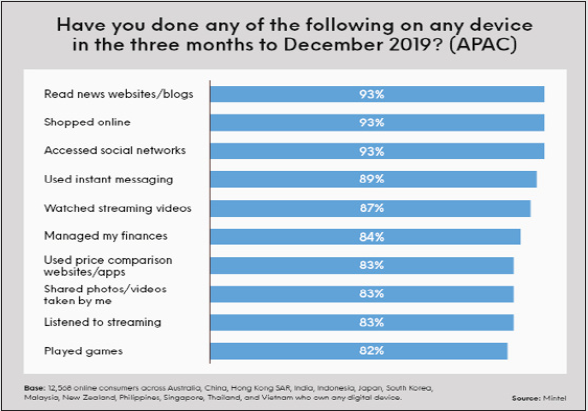
Figure 6: Cause of stress for Americans in 2015 as shown from a study of American Psychological Association(By courtesy of APA [20]).
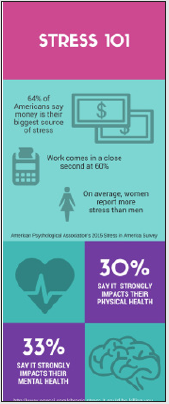
However, while on the one hand, a better cleaning of face and
hands to control the microbial growing seems to be the right key
for improving the overall skin health, on the other hand the healthy
bacteria balance, named microbiota, has not to be forgotten [26].
In conclusion, human health seems to be controlled not only from
the global skin ecosystem, represented by a community of bacteria,
viruses and fungi, but also from the continuous and direct body
exposure to pollution. All these aggressions, causing the oxidative
stress phenomena, contribute to the cells’ daily aging processes
which, as result of epi-genetic changes, may persist longer also
after the harmful exposure has ended. Consequently, clean air
and water with a safe environment are becoming worldwide a
must for consumers together with wellbeing and longevity. Thus,
people are forced to change their lifestyle, reducing production of
waste and the consumption of energy and water. The different way
of living is due to the increasing world population, predicted by
UN to reach 9.8 billion by 2050 and 11.2 billion by 2100 [27] and
climate crisis aggravated by the recent coronavirus infection. Thus,
the re-evaluation of older traditions, centered around heritage, will
bring communities to innovate more ethically,probably driving the
future policy and economics [17-19]. Moreover, it seems necessary
to create an immediate digital revolution and a new communitybased
organization to face COVID-19 and other future health
crisis, looking to the great limitations of means recovered in the
hospitals worldwide [23]. Therefore, better and more affordable
tele-communication technologies together with a more worldwide
collaboration between the different Countries will contribute to
create new products and services suited to all the local needs. Thus
new and flexible work conditions could be allowed and consumers
will have the possibility to be-come digital nomads, substituting the
business traveling by video conferencing with a reduced consume
of human energy and a lower production of greenhouse gas (GHG)
emissions [22,23,27]. In conclusion during the last ten years, the
world vision of a better appearance has been further evolved, so that
health and beauty became a must for any consumer and cosmetic
company [20-22,24-26]. Moreover, both consumers, women, and
men, became increasingly aware of the cosmetic naturalness and
impact on body and environment. They wish to know how the
products are made and which is the raw material source of origin,
controlling not only the prices but also their environmentally and
ethically respectful practice.
First of all, they are looking for cosmetic effectiveness and ecosustainability,
well knowing that around 120 billion units of cosmetic
packaging produced today are not recyclable [20-22,24-26].
Consequently, consumers are increasingly demanding zero waste,
100% recyclable packaging and fair-trade practices. Moreover, it
is mandatary that most of the cosmetic active ingredients have to
be of natural origin, coming from plant and herbs extracts from
sustainable sources, also if the actual definitions of cosmetic as
“natural, green, safe, organic, non-toxic”, are not clear enough. Thus,
by a 2019 study [20,21] it has been shown that nearly 70% of women
in USA read on the label the beauty product’ ingredients, prior to
make its purchase, also if it is nearly impossible to distinguish their
specific real effects, without knowing the dose used. Moreover, it is interesting to underline that actually and differently from 10 years
ago, the demand for personal care products, such as cosmeceuticals
and nutraceuticals, is increased in the same way between women
and men so that it has been estimated that the global cosmetic
products will range US$ 863 billion by 2024 for cosmetic &
toiletries market only [28-31] (Figure 7). According to Global
Data, 81 % of men say that “ health and wellness influence their
personal care and grooming purchase decisions” [31]. In 2018,
58% of EU men claim to use between 1-5 facial skincare product
daily to slowdown the wrinkles formation, and 1-5 use hair care
product to ameliorate their global appearance. Thus, use of face
mask(78% men!) as skin care routine has overwhelmed the women
skin care category [29,30]. Additionally, 38% of men are looking for
products packaged without any plastic at all. To further confusing
the consumers understanding, it has also appeared in the market
the so-called Athleisure, as a mainstream in the skincare and makeup
categories. This new niche of beauty products, compatible for
any kind of exercises, are marketed to consumers who, in search
for cosmetics before and after workouts, are active in maintaining
their lifestyle [30-33]. However, as previously reported, consumers
today are more concerned with impact of pollution and stressful
lifestyle on the skin and their global wellness and, therefore, are
looking for cosmetics and nutraceuticals which, of high quality
and environmentally and ethically friendly also because plasticfree,
are able to improve both body (skin) and mind. They, in fact,
are thinking that the interplay of physical, mental and nutritional
factors contributes to a healthier- looking appearance. Therefore,
customers are disconnecting themselves from technology to protect
their mental wellbeing, thus prioritizing what they truly want and
enjoy doing: the fear of missing out (FO-MO) are giving place to the
joy of missing out (JOMO) [30-33]. So doing, they have the possibility
to take control over what they put on their skin and what they
are eating, “customizing and personalizing the beauty products and
food to buy” [32].
The green economy today: Nanoparticles and biodegradable tissues
Ten years ago, in occasion of the reported ISCD international congress, it was focused and discussed the necessity to consider innovation and culture indispensable sounds for the progress representing “the basis for a sustainable chemistry veering towards the green economy” [1,34]. Today, according to the EU report on green economy (Figure 8), we are going on the same direction evidencing the necessity to change the actual way of living. Thus “whereas a circular economy focused on optimizing material resource by minimizing waste, the green economy approach extends the focus to how water, energy, land and biodiversity should be managed”, securing eco-system resilience and human wellbeing [34]. Thus, both production and consumption have to be integrated across the supply chain to ensure their efficiency improvement. Following this approach, our lab dedicated the majority of the research studies to develop green films and non-woven tissues by the use of two natural polymers: chitin and lignin, obtained from fishery’s by-products and plant biomass respectively [35-37].
These two polymers, used in their micro/nano-size, were
complexed by the gelation method to obtain micro/nano particles
(NPs) [38,39]. NPs, loaded by different ingredients were linked to
the polymeric fibers before starting the electrospinning or casting
process to produce non-woven tissues or films respectively [40-
43]. Moreover, the activity of the obtained tissues/films have
been characterized by the ingredients loaded into the respective
fibers used and, of course, by the polymers selected. Thus, it has
been possible to obtain tissue/films which, for their different
effectiveness and safeness , may be used as advanced medications
or facial/hair beauty masks [43]. However, all the tissue/films
obtained are skin-friendly and eco-friendly because easily
metabolized to safe molecules by human and the environment’
enzymes. Both chitin, lignin and their derived compounds have been
used in their nano-size showing, therefore, different properties if
compared to the normal counterpart’ dimensions. At this purpose
it is to remember, for example, that medium size chitin interacts
with the macrophage receptor TLR-2 to produce pro-inflammatory cytokines, such as IL-17, IL-23, TNF and TB4, while small size
chitin, as chitin nanofibrils (CN), induces the production of the
anti-inflammatory IL-10 (Figure 9) [44], contributing to increase
the skin repairing effectiveness. This activity of the advanced
medications realized by these CN-tissues has been confirmed by
our group both in vitro on human keratinocytes cultures [45] and in
vivo on human burns of 1st and 2nd grade [46,47]. In conclusion by
our research studies on these innovative tissues, it has been shown
the interesting impact the natural polymeric material may have
in today’s health and beauty technologies. The different structure
of chitin nanofibrils (CN), nanolignin (LG) and their complexes
seem to have the ability to govern morphology and property of the
obtained tissues, creating a molecular architecture able to repair
wounded and burned skin as well as photo-aged skin altered from
the UV and pollution aggression [48,49]. Assuredly, the antioxidant
and immunomodulatory effectiveness of both CN and LG seem to
be increased by their CN-LG complexes, also if the two polymers are
totally different in their structure.
However, for a better knowledge of the biological activity it
results essential to know and understand their own structureproperty
relationships in relation to their interaction with the
different skin tissue’ layers. It should be also interesting to verify
the antimicrobial properties of these complexes to know the type
of pathogen microorganisms on which they are acting, for the
necessity to don’t disturb the natural and physiological equilibrium
of the skin microbiota [50]. Moreover, it is also important to know
and understand the final physicochemical and biological structure
of the realized tissue/films. Tissue engineering of biomaterials,
in fact, are emerging as promising solution for both regenerative
medicine and cosmetic research to restore the skin integrity after
injury, such as wounds and burns or after the aggressive action
of UV and air pollutants, primary cause of photo-aging [51]. This
the important strategy followed by our and other study-groups
during the 2010-2020 period. However, the majority of studies
have shown that, for living in a healthy state without anxiety, it
seems necessity to maintain a clean air free of pollution, following
an equilibrated diet with right periods of relax . Moreover,
further increased from the actual COVID-19 diffusion, it has been
underlined the overall necessity to ameliorate the actual healthcare
system by a multidisciplinary field of research studies, necessary
to realize materials, products and scaffolds which, characterized by
their biomimetic activity, may lead to develop high quality tissues,
skin and environmentally-friendly. By these biodegradable tissues,
made by natural bio-polymers and obtained by waste materials,
such as the reported chitin and lignin, it will be possible to realize
and produce innovative surgical face masks and protective dailyuse
equipment totally skin- and eco-friendly, safeguarding human
health and the environment.
Figure 9: Depending on size, chitin stimulates the release of anti-inflammatory or pro-inflammatory citokines (by courtesy of [44]).

Conclusion
With the actual climate and regulatory pressure, the sustainability has to be at the core of every business strategy. It has to address the right technology and innovation, necessary to solve the intolerable increasing of waste and GHG emissions, cause of the environmental disasters which are rushing the planet. On the other hand, diseases and traumatic injuries are increasing worldwide because of the increased aging population [52] where, the aged over 60 years numbered 962 million in 2017,is expected to double by 2050,reaching nearly 2.1 billion people [53]. Thus, the necessity to increase our knowledge on the tissue regeneration processes and the consequent applicability of specific scaffolds made by selected and electrospun natural fibers, which seem to have the same structure of the natural ECM. The mechanism by which cells adhere on nanofibers, in fact, is not completely understood, also if skinfriendly molecules seem to have the capacity to be easily adsorbed, adhering selectively on human structures [54]. However, adhesion is the first biological event that take place when a cell seed onto a substrate as, for example, the fiber, and is attached on it.Soon after the cell,specifically enhanced by the presence of collagen,may begin to migrate, proliferate, differentiate or synthesize ECM [50]. Natural ECM scaffold,in fact, supports cell fate, providing a substrate for cell signaling, thus activating proliferation, differentiation, matrix production and eventually its apoptosis [54,55].
But how ECM is working?
This natural structure dictates the cell activities by the content of fibers, such as collagen, acting as a protein mediator within the cellular microenvironment. Thus collagen, regulated by the structural curvature of its fibrils, adheres to the cell surface via specialized receptors, providing biological signaling and tensile strength [56]. These could be the nano topographical features of CN and LG, by which they have the capability to enhance the cell adhesion ,thanks to their small size and the increased surface-tovolume ratio. Therefore, due to their nano-structured organization, the chitin and lignin’ complexes could carry molecules (for both therapeutic or cosmetic applications) by the use of specialized tissues with the ability to target and release the loaded molecules in predetermined spatially-and temporally-controlled man-ner. However, the innovative nanoparticles of the cationic chitin nanofibrils and the anionic nano-lignin or hyaluronic acid, due to their different electrical charges, may be easily complexed by the gelation method in water solution (Figure 10) [35-43]. The NPs, used as a water suspension or obtained as powder by the spray dryer technology, may be enclosed into emulsions or linked to the fibers’ surface for producing non-woven tissues or films. Moreover, according to the de-sired and designed activity, it is necessary to characterize the NPs’ effectiveness, encapsulating into their structures different active ingredients for obtaining cosmeceuticals or medical products, as previously reported. It is interesting to underline that the encapsulated active ingredients may be easily released at different time, according to the structure of the emulsion and/or the tissue realized. Thus, on the one hand these innovative emulsions/tissue-cosmeceuticals could promote a healthy barrier for an aged skin, preventing water loss and dryness, thus slowing down the wrinkle’s formation.
On the other hand, the obtained advance medications could modulate the granulation tissue of a wounded skin, promoting a more regular cells turnover, thus activating a more rapid skin repairing effectiveness. At this purpose it is to underline once again the importance of the polymers used to realize the designed tissue-structure , that could be useful for trying to minimize the microorganism’s aggression. Just as an example, the duration of virus on cloths seems to depend on the fabric porosity because more porous material could catch more virus particles. Thus, for example the man-made poly-ester polymers retain germs longer than, for example, the natural breathable cotton-based fabric. According to thousands of research study of the last ten years, therefore, it appears necessary to leave the linear economy to go on by the circular/green economy (Figure 11) [57], for satisfying the consumer requests and saving human health and the planet’ ecosystem. At this purpose, it is, necessary to underline again that 91% of the world’s population lives in place where air pollution exceeds healthy limits because of the increasing pollution and a non-recycled waste, cause of many diseases and the recent environmental disasters. Thus, the necessity of a green/bleu revolution able to change production and consumption, following new smart and eco-methodologies [58]. This new economy is named green for the necessity to use the agroforestry biomass and blue for the utilization of waste coming from fishery’s by-products, just as the reported lignin and chitin [57]. Therefore, for living in a world more nature-oriented and trying to solve quickly, not only the great problem of food and plastic waste, but also a new and unsuspected future crisis, such as the actual COVID-19 pandemic, it will be necessary to change the consumer/ market behavior and the global way of thinking and living. As consequence all the developing and developed technologies coming from universities and industries have to be quickly utilized, accepting the emerging knowledge. In conclusion, evaluating, anticipating and, solving all the problems by sustainable bio-nano- technologies at zero waste, would be considered a must of our society to maintain human wellbeing and the planet biodiversity [59].
Figure 11: Linear versus circular economy according to EU (by courtesy of EEA).
Source: EEA Report No 2/2016
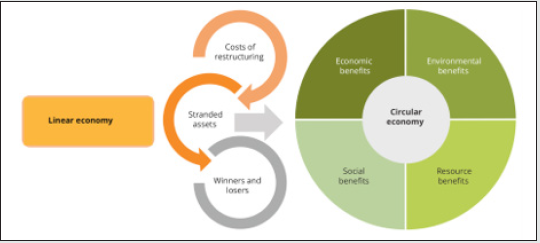
Author Contribution
conceptualization PM; writing-original draft preparation PM and MBC; writing review and editing author contribution PM, MBC and GM; supervision HDC and AM.
Consent for Publication
Not applicable.
Funding
None.
Conflict of Interest
The authors declare no conflict of interest, financial or otherwise.
Acknowledgements
Declared none.
References
- Morganti P (2010) Beauty and Wellness at 360. J Appl Cosmetol 28: 13-24.
- Kluwe RH, Luer G, Rosler F (2003) Princples of Learning and Memory. Birkhauser ,Basel, Switzerland.
- Peters A, McEwen BS, Eripton K (2017) Uncertainty stress: why it causes diseases and how it is mastered by brain. Prog Neurobiol 156: 164-188.
- Kim KE, Cho D, Park HJ (2016) Air pollution and skin diseases: Adverse effects of airborne particulate matter on various skin disease. Life Sci 152:126-134.
- WHO (2020) Air Pollution -Overview, World Health Organization.
- Trnovec T, Cook T, Kahayova K, Nyulassy S (2001) Civilization as a threat to human health? Cent Eur J Public Health 9(1): 49-52.
- Dan Mrejeru (2019) Augmentation and the Illness of civilization. Kindle Edition, Erlink Print & Media.
- Peters A, Kubera B, Hubold C, Langemann D (2011) The selfish brain: stress and eating behaviour. Frontiers in neuroscience 5(74): 1-11.
- Ye Q, Wu Y, Gao Y, Li Z, Zhang C (2016) The 'selfish brain' is regulated by aquaporines and autophagy under nutrient deprivation. Mol Med Rep 13: 3842-3848.
- Kerman AS, Mitra AK (2000) Structure and Funtion of Aquaporin Water Chanels, Am J Physicol Renal Phisiol 278: F13-F28.
- (2000) Keyo University. Theme 1. Cell Biology of Aquaporins,Keyo University School of Medicine.
- Ikasashi N, Kon R, Kaneko M, Mizukami N, Kusunoki J, et al. (2017) Relationship Between Aging-Related Skin Dryness and Aquaporins. Int J Mol Sci 18: 1559.
- Gamma G, Valenti G, Grossini E, Donnini S, Marino A, et al. (2018) Aquaporin Membrane Channels in Oxidative Stress, Cell Signaling and Aging:Recent Advances and Research Trends. Oxidative Medicine & Cellular Longevity 2018: 1501847.
- Yasui M (2004) Molecular mechanisms and drug development in aquaporin water channel diseases:Structure and functions of aquaporins. J Pharmacol Sci 296(5567): 523-530.
- Jones AL, Kramer RSS (2016) Facial Cosmetics and Attractiveness :Comparing the Effects Sizes of Professionally Applied Cosmetics and Identity. PLOS One 11(10): e0164218.
- Morganti P (2020) Salute e Bellezza nel Dopo Coronavirus 20(197):50-57
- Adyel TM (2020) Accumulation of Plastic Waste During COVID-19. Science 319(6509): 1314-1315.
- Mintel (2020) Global Beauty and Personal Care Trends.
- Yarosh DB (2019) Perception and Deception: Human Beauty and the Brain. Behav Sci 9: 34.
- Jokela M (2009) Physical Attractiveness and Reproductive Success in Humans: Evidence from the late 20th Century United States. Evol Hum Behav 30: 342-359.
- Khanom R (2019) Why personalization is the future of beauty. Mintel, UK.
- Morganti P (2019) Natural Products Work in Multiple Ways. A Tabor, R Blair (eds.), Nutritional Cosmetics. Beauty from Within, 2009,William Andrew Publishers, Oxford, UK, pp 95-111
- Crabbe M (2020) Research your way out of a crisis:Covid-19 effect on consumer Behaviour. Mintel, UK.
- Shi R(2020) How Covid-19 is changing grocery shopping in China. Mintel, UK.
- Lam J (2019) I follow me: embracing individuality and diversity. Mintel, UK.
- Morisini D (2019) Can your skin ever be too clean?, Skin Care & Dermatology.
- UN (2017) World Population Increase, Department of Economic and Social, United Nations, New York, USA.
- Keesara S, Jonas A, Schulman K (2020) Covid-19 and Health Care's Digital Revolution. NJ Med NEJM Org by Massachusetts Medical Society 382(23): 82.
- Culliney K (2019) Gender gap? Men's personal care lacking in health and beauty subscriptions. MINTEL,UK.
- Mattews I (2019) Who are the men behind the skin(skin care) masks? Happy 56(3): 1-100.
- Global Data(2018) Five cosmetic trends that transformed the industry in 2018.
- Angus A, Westbrook G (2019) Top 10 Global Consumer Trends 2019. Euromonitor International Report, UK.
- Badge P (2018) Beauty Survay 2018 Key Insight. Euromonitor International, UK.
- EU (2015) Green Economy Report.
- Morganti P, Tischenko G, Palombo M, Kelnar I, Brozova L, et al. (2013) Chitin Nanofibriks for Biomimetic Priducts: Nanoparticles and Nanocomposite Chitisan Films in Health Care. Se-Kwon Kim (Eds.), Marine Biomaterials. Characterization, Isolation and Applications CRC Press, Boca Raton FL, USA pp. 681-715.
- Morganti P, Danti S, Coltelli MB (2018) Chitin and Lignin to produce Biocompatible tissues. Res Clin a Dermatol 1(1): 5-11.
- Tishchenko G, Morganti P, Stoller M, Kelnar I, Mikesova J, et al. (2019) Chitin Nanofibrils-chitosan Composite Films: Characterization and Properties. P Morganti (Eds), Bionanotechnology to Save the Environment. Plant and Fisschery's Biomass as Alternative to Petrol, MDPI, Basel, Switzerland pp. 191-226.
- Morganti P, Febo P (2018) Innovative tissue engineering to enlarget market. J Clin Cosmet Dermatol 1(4): 119.
- Morganti P, Del Ciotto P, Morganti G, Fabien-Soule' V (2012) Application of Chitin Nanofibrils and Collagen of Marine Origin as Bioactive Ingredients. Se-Kwon Kim (Eds.), Marine Cosmeceuticals .Trends and Prospects CRC Press, Boca Raton FL, USA, pp. 267-290.
- Morganti P, Coltelli MB (2019) A new carrier for advanced cosmeceuticals, Cosmetics 6(1): 10.
- Danti S, Trombi L, Fusco A, Azimi B, Lazzeri A, et al. (2019) Chitin Nanofibrils and Nanolignin as Functional Agents in Skin Regeneration. Int J Mol Sci 20(11): 2669.
- Morganti P, Morganti G, Colao C (2009) Biofunctional Textiles for Aged Skin. Biomedicines 7: 51.
- Morganti P, Morganti G and Coltelli MB (2019) Chitin Nanomaterials and Nanocomposites for Tissue Repair. AH Choi, B Ben-Nissan (Eds.), Marine-Deived Biomaterials for Tissue Engineering applications Singapore, Springer, pp. 523-544.
- Lee CG, Da Silva CA, Lee JY, Hartl D, Elias AC (2008) Chitin Regulation of Immune Responses :An Old Molecule with New Roles, Curr Opinion Immunol 20(6): 684-689.
- Morganti P, Fusco A, Paoletti I, Del Ciotto P, Palombo M, et al. (2017) Anti- inflammatory ,Immunomodulatory and Tissue Repair Actuvity on Human Keratinocytes by Green Innovative Nanocomposites, Materials 10(7): 843.
- Morganti P, Anniboletti T, Pollastrini C, Morganti G(2019) Natural Polymers for Body Care to Save the Environment. Biomed J Sci & Tec Res.
- Anniboletti T, Palombo M, Moroni S, Bruno A, Palombo P, Morganti P (2019) Clinical Activity of Innovative Non-woven Tissues. P Morganti (Eds.), Bionanotechnology to Save the Environment. Plant and Fishery's Biomass as Alternative to Petrol, MDPI, Basel, Switzerland pp. 340-360.
- Damevska K, Nikolovska S, Kazandjieva J, Trifunova BY (2019) Skin and Pollution. K Franca, T Lotti (Eds.), Integrative Dermatology, Wiley & Sons, Hoboken, New Jersey, USA, pp 371-392.
- Morganti P, Morganti G, Coltelli MB (2020) Skin & Pollution. The Smart Nano-Based Cosmeceuticals to Save the Planet' Ecosystem. A Nanda, S Nanda, TA Nauyen, S Rajendran, Y Slimani (Eds.), Nanocosmetics: Fundamentals, Applications and Toxicity New York USA.
- Relman DA (2012 ) The Human Microbiome: Ecosystem Resilience and Health. Nutr Rev 70(Suppl 1): S2-S9.
- Zegarska B, Pietkun K, Zegarski W, Bolibok P, Wisniewski M, et al. (2017) Air pollution,UV irradiation and skin carcinogenesis:What we know where we stand and What is like key to happen in the future? Adv Dermatol Allergol 34(1): 6-14.
- Jaul E, Barrin J (2017) Age-Related Diseases and Clinical and Public Implication for 85 Years old and over Population, Front Public Health 5: 335.
- UN (2017) World Population Ageing 2017.Department of Economic and Social Affairs, United Nations New York, USA.
- Woo KM, Chen VJ, Ma PX (2003) Nano-fibrous scaffolding architecture selectively enhances protein adsorption contributing to cell attachment. J Biomed Mater Res A 67(2): 531-537.
- Baker BM, Handorf AM, Ionescu LC, Li WJ, Mauck RL (2009) New directions in Nanofibrous scaffolds for soft tissue engineering and regeneration , Expert Rev Med Devices 6(5): 515-532.
- Hoshiba T, Yamaoka T (2019) Extracellular Matrix Scaffolds for Tissue Engineering and Biological Research. T Yamaoka, T Hoshiba (Eds.), Decellularized Extracellular Matrix: Characterization, Fabrication and Applications, Royal Society of Chemistry, UK, pp. 1-4.
- EEA (2020) Waste in EU Economy from Linear- to Circular Economy. Circular Economy.
- Christian (2019) A green and Bleu revolution to save the Planet and our health, Maritime Forum.
- Morganti P, Chen Hong-Duo, Morganti G (2020) Nanocosmetics: Future Perspective. A Nanda, S Nanda, TA Naujen, S Rajendran ,Y Slimani (Eds.), Nanocosmetics: Fundamentals, Applications and Toxicity ,Elsevier Book, NY, USA.

Top Editors
-

Mark E Smith
Bio chemistry
University of Texas Medical Branch, USA -

Lawrence A Presley
Department of Criminal Justice
Liberty University, USA -

Thomas W Miller
Department of Psychiatry
University of Kentucky, USA -

Gjumrakch Aliev
Department of Medicine
Gally International Biomedical Research & Consulting LLC, USA -

Christopher Bryant
Department of Urbanisation and Agricultural
Montreal university, USA -

Robert William Frare
Oral & Maxillofacial Pathology
New York University, USA -

Rudolph Modesto Navari
Gastroenterology and Hepatology
University of Alabama, UK -

Andrew Hague
Department of Medicine
Universities of Bradford, UK -

George Gregory Buttigieg
Maltese College of Obstetrics and Gynaecology, Europe -

Chen-Hsiung Yeh
Oncology
Circulogene Theranostics, England -
.png)
Emilio Bucio-Carrillo
Radiation Chemistry
National University of Mexico, USA -
.jpg)
Casey J Grenier
Analytical Chemistry
Wentworth Institute of Technology, USA -
Hany Atalah
Minimally Invasive Surgery
Mercer University school of Medicine, USA -

Abu-Hussein Muhamad
Pediatric Dentistry
University of Athens , Greece

The annual scholar awards from Lupine Publishers honor a selected number Read More...




